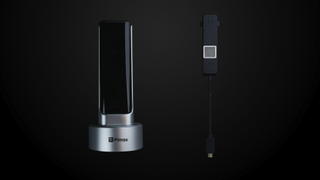Pimax’s new VR headset can switch between QLED and OLED screens – but the Vision Pro beats it in one major way
Pimax has unveiled two new VR headsets, with the top-end Pimax Crystal Super seemingly set to put the best VR headsets to shame – even the Apple Vision Pro – with some phenomenal specs. It also has one of the most unique display features we’ve ever seen: you can switch between an OLED and QLED display engine to get the most out of your virtual experience.
Are you playing a terrifying horror adventure where you explore dark spaces full of monsters? Then the excellent dark contrast of an OLED screen is exactly what you need. Instead, if you kick back with a vibrant social VR app, you can trade in the QLED screen for being dazzled by the colors it can produce.
Whichever screen type you choose, the Pimax Crystal Super delivers 29.5 million pixels on its dual 3,840 x 3,840 pixel displays per eye, each with 200 nits of brightness. The QLED display system has a maximum refresh rate of 120 Hz and uses glass aspherical lenses, while the OLED system has a maximum refresh rate of 90 Hz and uses less bulky pancake lenses.
You’ll also find useful features like eye-tracking, dynamic foveated rendering and inside-out tracking – so no lighthouses required.
As you’d expect, this interchangeable display design doesn’t come cheap. If you want a Pimax Crystal Super with both the OLED and QLED display engines, you’ll pay $2,399 (about £1,925 / AU$3,700) for the headset. If you prefer to have just one type of screen, the QLED model will cost you $1,799 (about £1,450 / AU$2,800), while the OLED version will cost you $1,999 (about £1,600 / AU$3,100).
No exact release date has been given yet, but Pimax estimates that the Crystal super will be launched in the fourth quarter of 2024 (so October, November or December).
If all this is still too much to pay for a VR headset – especially if you need a comparable high-end PC gaming rig so you can get the most out of your headset’s capabilities – or if you want a headset which arrives earlier you can opt for the Crystal Light instead.
The Crystal Light has less sharp displays – with only 2,880 x 2,880 pixels per eye – although the QLED screen can reach up to 120 Hz. However, it uses aspherical lenses so will be bulkier than headsets with pancake lenses, and it lacks eye-tracking and dynamic display capabilities.
The result is that it’s a lot cheaper starting at just $699 (about £550 / AU$1,100) and should launch in May, according to Pimax.
As impressive as these new Pimax headsets sound, I’m disappointed that they’re stuck in the PCVR ecosystem and don’t at least adopt Pimax’s proprietary wireless technology.
Analysis: A few steps forward, a few steps back
A major problem with PCVR headsets are the cables that tether you to a PC (or a console in the case of PSVR 2) that restrict your freedom of movement, and you can catch yourself fumbling around in virtual reality.
However, as we’ve seen from the screens in the Pimax headset, the advantage of PCVR is that you can enjoy super high levels of graphics and performance that are better than standalone devices – such as the Meta Quest 3 and even Apple Vision Pro (on provided you have a great PC, that is).
This is where a wireless module can come in handy, such as the Pimax Crystal 60G Airlink device, as it allows you to enjoy PCVR without being tethered. We’ve known this device was coming for a while – it was already demoed at CES 2024 – but we finally know exactly what the Crystal 60G can do with official specs straight from Pimax.
Notably, it features wireless PCVR with a resolution of 2,880 x 2,880 pixels per eye, a maximum refresh rate of 90Hz and “ultra low latency” – although exactly what this means hasn’t been revealed.

Unfortunately, none of Pimax’s new headsets – the Crystal Super or Crystal Light – support the 60G Airlink module.
Additionally, they removed the batteries and Qualcomm Snapdragon XR2 chipset that came in the base Pimax Crystal headset, allowing it to support both wireless PCVR and a standalone VR experience.
That’s why the base Crystal model could be the better option for you – or a non-Pimax model like a Quest 3 or Apple Vision Pro – thanks to the versatility a standalone headset offers. Not only are you freer to use the headset wherever you want, but you can also easily use these headsets, with the exception of the Vision Pro, for wireless VR and for wired PCVR – giving you the best of both worlds.
This versatility is one of the reasons Quest headsets top the list Steam VR usage tables for years.
Considering how impressive Pimax’s machines are, I’d love to see it continue to push into the world of standalone VR. Improving the software catalog or partnering with a company with a great VR operating system to kick-start the app store – ideally the great Quest ecosystem, but there are others like HTC – would have been great too.
I’ll have to try out the latest Pimax headset for myself before giving my final verdict, but as it stands I don’t think these are VR gadgets I’ll see most people using – and I don’t think most people will use them either should use. That’s a real shame, because otherwise I think Pimax’s machines could be a blow to expensive competitors like the Vision Pro. But for now, I feel like relative newcomer Apple has, on paper, beaten Pimax’s Crystal Super.
